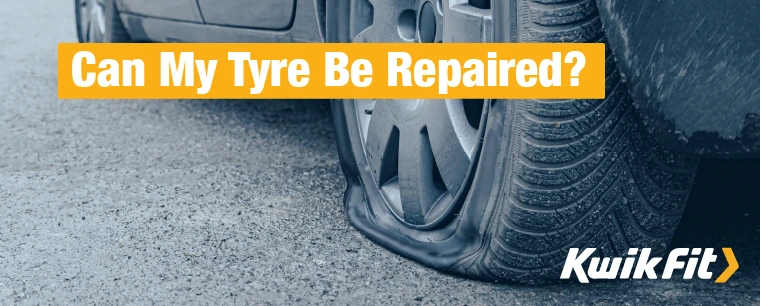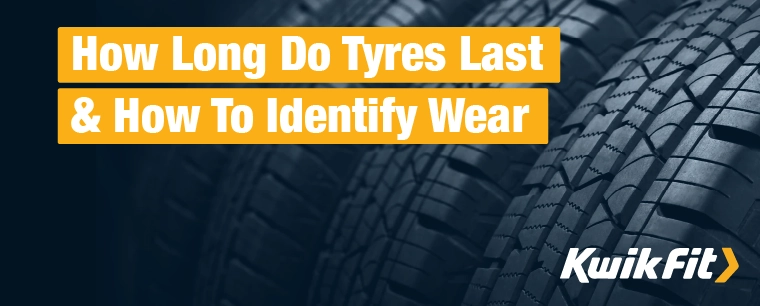How to Clean Your Car’s Tyres
Jack Dreyer | Wednesday 21st February 2024 8:45am
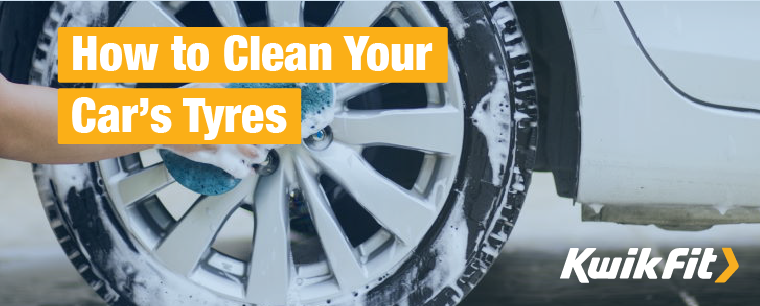
Tyres are often overlooked when it comes to washing the car. However, since they are the dirtiest and most used element of your vehicle, surely they deserve a good clean now and then?
The shiny, black ‘new tyre’ look is highly sought-after nowadays. Having black tyres makes a car look sleek and well cared for. That’s why so many car enthusiasts and regular drivers alike are spending more and more time on their tyre upkeep.
Treat your tyres to some TLC and keep your vehicle sparkling clean with this handy guide put together by our tyre experts.
Why clean your tyres?
Many drivers skim over their tyres when cleaning the car using the argument ‘They’ll just get dirty again anyway!’. Admittedly, this approach might save a bit of time, but it actually compromises on safety.
Not many people make the connection between tyre care and road safety but shinier tyres mean fewer rust spots and, ultimately, a safer car. Since tyres comprise of rims, hubs, and spokes, there are lots of hidden nooks and crannies where rust can accumulate and weaken tyres over time; hence why a rigorous cleaning routine becomes almost like a safety procedure.
How to clean your tyres and keep them black
There are a number of steps that you can follow to maintain your tyres and return them back to their original black colour.
Take a look at our guide below.
1. Prep & park
Find a well-ventilated, flat surface away from the road and any dirt or debris. The last thing you want is for a lorry to rush past and splatter mud all over your clean rims.
Gather your equipment and have it close to hand so you can get the job done quickly without pausing to search for a brush or a rag. Dedicate one cloth to drying and another to applying products so that you don’t accidentally tarnish the work you’ve done.
Before starting any inspection or handling of your tyres, however, make sure they have cooled down from driving. While you wait, take the opportunity to grab a kneeling pad or seat to make the work easier while reading the instructions on the products you’ll be using.
2. Hose off your tyres
Use a hosepipe on a high setting to blast off the grime, making sure to approach the tyre from all different angles to reach behind the spokes. Take care not to damage the tyres.
You may see dark brown sediment running off the tyres at this point — this is just common brake dust that has accumulated and solidified. If you are using a degreaser o
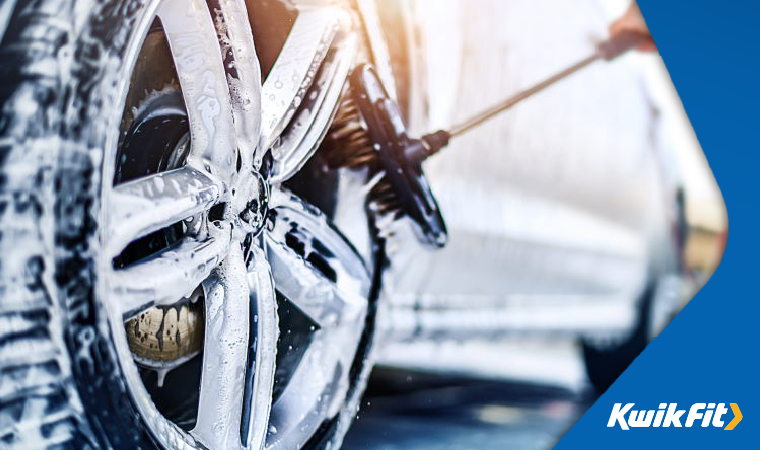
3. Brush & wash
A soft-bristled brush should now be used to scrub the rim of your tyres, while a hard-bristled brush can remove dirt from the surface of your tyres and treads.
Start by cleaning the tyre first so that excess dirt does not run down the clean wheel face and ruin your hard work. Use a solution of soapy water to gently cover the rubber surface sidewall of each tyre. For a more up-market option, you might want to consider investing in a store-bought tyre cleaning spray. This soapy coating should be left to sit on the tyre sidewalls for a few minutes.
Apply a moderate amount of pressure to lift off any remaining dirt not removed by the hose and, for the best results, rinse the brush between tyres to avoid transferring any dirty residue. Try to remove as much dirt as possible, all the while keeping the tyres wet so that your scrubbing efforts don’t cause any scratching.
4. Dry
If you have it, use a soft microfiber cloth to dry both the tyre and the rim. Microfiber cloths are generally better than normal rags as they absorb all the water without smearing it across the wheel face causing wax products to apply unevenly.
5. Wax
As an optional extra, you can wax your tyres. If you’re using wax, wait until the tyres have dried completely before applying it. Use a wax pad to apply the product to the tyre and polish it the same way you would the body of the car. Once an even coating has been polished in, remove any excess to avoid discolouration damage and then leave the wax paste to dry.
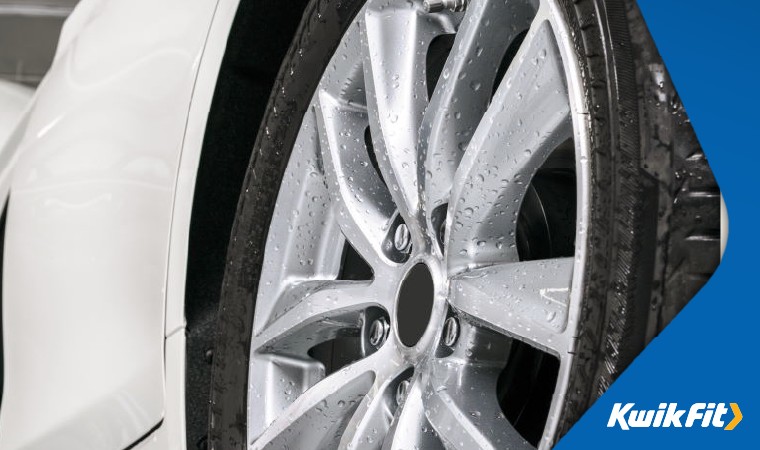
6. Dressing
One of the leading options for tyre shine enhancement, tyre dressing is a popular product. Consisting of a water-based solution and silicone, tyre dressing is a specially-formulated chemical solution that restores the sheen and ‘blackness’ of rubber tyres as they fade over time.
Working like a fresh coat of paint, or a lubricant, tyre dressing immediately blackens and enhances the gloss of your tyres. Some, however, also contain a UV reflecting agent that protects your tyre walls against sun damage — this is particularly useful for old tyres.
Despite there being multiple types of dressing — regular, wax, and sealant — it is extremely easy to use. The only difference between each type is that wax lasts longer in the rehydration of tyre rubber due to its slightly adhesive properties.
How often should you apply tyre dressing?
Generally speaking, the more regular your tyre dressing maintenance, the shinier your tyres will be. It is advised, though, that every fortnight is a suitable amount of time.
7. Repeat
We recommend performing the full process on each separate tyre at a time so that the tyres don’t dry out while ensuring you don’t miss a step. When one tyre is complete, move on to the next.
In general, a thorough tyre clean like this one should be done every two months in order to keep your tyres looking clean and lasting longer due to the increased maintenance.
How to get tar off your tyres
If the dirt on your tyres still won’t budge after performing all the processes mentioned above, you might have tar stuck to them. Tar on your tyres can drastically reduce braking distances and make journeys in the car uncomfortable and, most importantly, unsafe.
Don’t worry though, tar is relatively easy to remove. Spend more time on the scrubbing stage and use a hard-bristle brush with some warm, soapy water to lift the tar.
If it’s proving stubborn, gently take a plastic tool and try to lift the tar manually — be careful not to pierce or puncture the tyre during this process. If this still doesn’t work, you may want to consider investing in some tar remover or make your own remover at home with linseed oil. Simply pour
Get your tyres checked
If you have any questions about your tyres, or you’ve noticed any causes for concern while cleaning, get in touch with our experts today or book a free tyre check at your nearest Kwik Fit centre.
Any facts, figures and prices shown in our blog articles are correct at time of publication.
Featured Articles
Can My Tyre Be Repaired?
Wednesday 22nd November 2023
It can be hard to tell if your puncture can be repaired or not. Read our handy guide to understand if your tyre can be saved or if you need a replacement.
How Long Do Tyres Last & How To Identify Wear
Wednesday 18th October 2023
Driving on old or worn tyres can be dangerous so you need to maintain them properly. Read about how long tyres should last and how to know if your tyres are old.
Wet Weather Driving Tips – Staying Safe in the Rain
Thursday 27th October 2022
Driving in the rain isn’t only a pain but can be surprisingly hazardous – here are our top tips for staying safe in wet & icy weather this winter.

